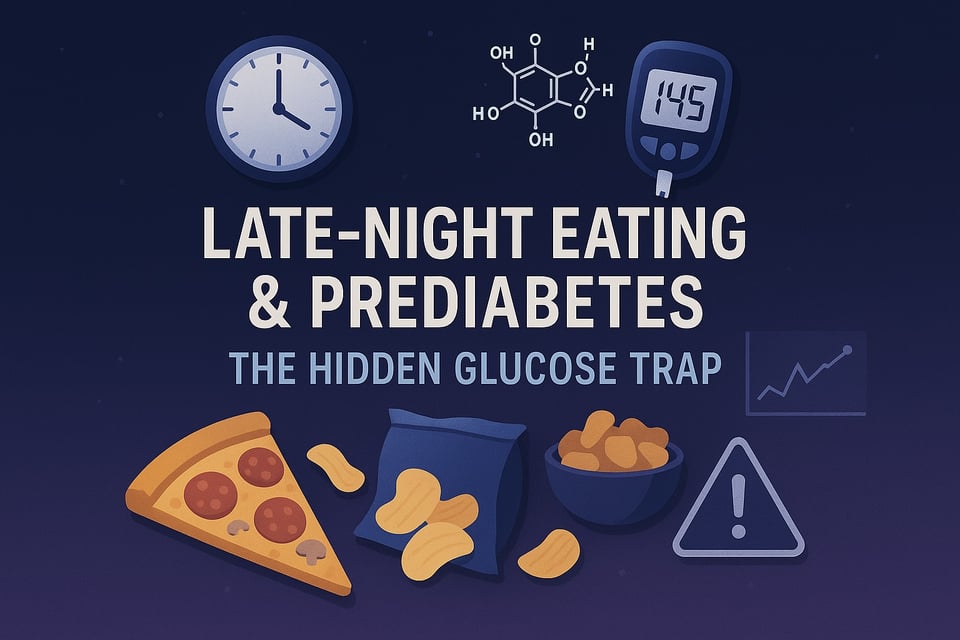Why Late Dinners Can Secretly Spike Your Glucose

🍽️ Late-Night Eating & Prediabetes: The Hidden Glucose Trap
When most people think about prediabetes, they zoom in on carbs, calories, or sugar.
But there’s another factor quietly shaping your blood sugar: time.
A 2018 Diabetologia study found that eating the same dinner at 10PM instead of 6PM led to an 18% higher glucose spike — even though the food, calories, and person were identical.
The only thing that changed? The clock.
🌅 Before the Light Bulb Changed Dinner
A couple of centuries ago, people rose with the sun and wound down with dusk.
Dinner ended when daylight did — no glowing screens, no streaming shows, no late-night fridge raids.
Then came Edison’s light bulb — and our evenings started stretching longer.
Workdays ran later, dinners drifted later, and nighttime slowly lost its boundary.
But our biology didn’t change with it.
Your body still runs on a circadian rhythm — an internal 24-hour clock that tells your metabolism when to be active and when to rest.
At night, your insulin sensitivity drops, meaning your body becomes less efficient at handling glucose.
So that same pasta dinner at 10PM hits harder than it would at 6PM — not because of the pasta, but because your body’s already preparing for sleep.
🧠 The Late-Night Trap
Late-night eating doesn’t just affect blood sugar — it can also mess with sleep quality, hunger hormones, and next-morning glucose.
It’s a quiet cycle that keeps many people stuck in higher readings despite eating “healthy.”
And if you’re thinking,
“Wait — are you telling me to eat a Mediterranean diet, but at Scandinavian dinner time?”
Not at all. 😄
This isn’t about strict rules — it’s about awareness.
We all have work, families, and lives that don’t always allow perfectly timed dinners.
When you can, try finishing dinner a bit earlier.
When you can’t, give yourself grace.
Your metabolism responds to consistency, not perfection.
🧩 Quick Myth Check
Many people believe that healthy food cancels out late timing.
But even the cleanest meal — salad, oats, grilled chicken — can spike higher when eaten late.
That’s because your insulin sensitivity dips after dark.
So it’s not just about what you eat, but when your body’s ready to handle it.
⏰ Gluco-Friendly Timing Tips
✅ Finish dinner 2–3 hours before bed
✅ Dim the lights post-dinner — bright light tells your brain it’s still “daytime”
✅ Eat balanced meals earlier to prevent late-night hunger
✅ If you eat late, go lighter on carbs and add protein or fiber
Even small shifts can make a big difference in both glucose and energy — without overhauling your diet.
🧭 The Takeaway
Our evenings may have stretched longer, but our biology still runs on ancient light.
Eating in sync with your body’s rhythm helps stabilize blood sugar, improve sleep, and steady your energy.
Because sometimes, the best thing you can do for your metabolism isn’t changing your food — it’s changing your meal timing. 🕒
🏁 Reader Challenge
This week, try this small shift:
👉 Move your dinner 30 minutes earlier for just 3 nights.
Notice how your sleep feels — and see if your fasting glucose or morning energy improves.
It’s a small experiment your metabolism will quietly thank you for. 💫
💬 A Quick Note from GlucoSpike
Catching sugar spikes early can prevent years of medication and frustration later.
With GlucoSpike AI, just snap your meal and see how timing — not just food — impacts your glucose.
Available on the App Store and Play Store.
